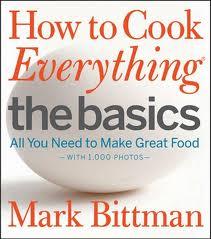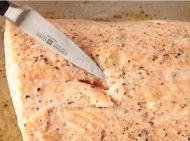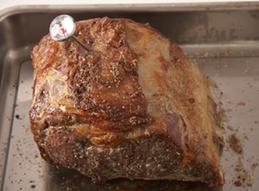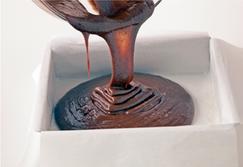How to Cook Everything The Basics by Mark Bittman (Wiley, $35 hardcover, 9780470528068, March 19, 2012)
 Mark Bittman is so confident about his prowess with food that he calls his series of cookbooks How to Cook Everything, and after using his cookbooks, thousands agree that his confidence is not misplaced. The books are big, they are densely packed with recipes and ideas, and they assume a certain level of competence and knowledge. But even the seasoned cook may wonder at times about certain things: dotting with butter--how small should the pieces be, how far apart? Batter for frying should be the consistency of thin pancake batter, but what if you don't make pancakes? Buttermilk biscuits shouldn't be overstirred--but what should the dough look like before that fatal overstirring?
Mark Bittman is so confident about his prowess with food that he calls his series of cookbooks How to Cook Everything, and after using his cookbooks, thousands agree that his confidence is not misplaced. The books are big, they are densely packed with recipes and ideas, and they assume a certain level of competence and knowledge. But even the seasoned cook may wonder at times about certain things: dotting with butter--how small should the pieces be, how far apart? Batter for frying should be the consistency of thin pancake batter, but what if you don't make pancakes? Buttermilk biscuits shouldn't be overstirred--but what should the dough look like before that fatal overstirring?
Now, with How to Cook Everything The Basics, Bittman has broken recipe instructions down to the most basic level, with photographs by Romulo Yanes illustrating both dish and technique. There is a photograph of butter dotting--the size of the dots and the space between them; a photograph of batter for frying, threading from a whisk; biscuit dough--what the ingredients look like in a proper "shaggy mess." Ever wondered how to peel ginger without losing half of it? It's not just you--it really is tricky unless you don't mind leaving behind a lot of peel and root.
But even before explaining (and showing) the difference between a boil and a simmer, or the right way to hold a knife, Bittman starts with setting up a kitchen. If you think this is a skippable section, think again--you may want to clear out your pantry and start over after reading what he suggests. For instance, if you don't use rice and other grains within six months, or flour and cornmeal within three, you should freeze them. Dried pasta? It's usually assumed that the best comes from Italy; Bittman agrees, but notes that price is not a measure of quality, it's good as long as it's Italian. As for kitchenware, Bittman is no Martha Stewart--if you're worried about lack of serving ware, just dish up food in the kitchen, he says. You need only three knives, but they must be the best you can afford. Kitchen towels should be cotton and changed every day. It's best to have one brush for meat and one for everything else, and you can save money by buying paintbrushes. Use a ruler to measure until you are comfortable eyeballing cubes and slices. Now you are ready to boil and simmer.
The chapters and recipes progress from easiest to most challenging, starting with breakfast and buying real maple syrup ("incomparably delicious, a gift from nature"), cooking breakfast meats, cooking oatmeal, making smoothies and then... eggs. This section showcases the value of the photographs. Bittman first shows the difference between eggs boiled for five different times, then moves to creamy scrambled eggs, showing what the eggs look like when starting to set, which is when you can add other ingredients. Fried eggs--okay, even showing you how to flip an over-easy egg won't negate the need for practice, but it does give you hope. And then the egg Waterloo for so many: poached. But he also has a substitute for this: the six-minute egg.
 Another food that many are nervous about cooking is fish, but Bittman reassures: the more you cook fish, the better you'll become at visually recognizing doneness without cutting and looking. Roasted Salmon with Butter is a good place to start. The center should be bright pink and still a little translucent, and in the photo you can see the color to look for--if it gets any paler on the outside, it will become overcooked and dry. He adds a few variations on this simple but fabulous dish with Herb-Roasted Salmon and Salmon Roasted with Olives and Thyme.
Another food that many are nervous about cooking is fish, but Bittman reassures: the more you cook fish, the better you'll become at visually recognizing doneness without cutting and looking. Roasted Salmon with Butter is a good place to start. The center should be bright pink and still a little translucent, and in the photo you can see the color to look for--if it gets any paler on the outside, it will become overcooked and dry. He adds a few variations on this simple but fabulous dish with Herb-Roasted Salmon and Salmon Roasted with Olives and Thyme.  For meat, try Perfect Roast Beef, with Bittman's perfect instructions. You won't worry about messing up an expensive prime rib if you follow them. His tips: check the temperature early and often; roast some potatoes in the same oven; and turn the heat up to 450 for the last few minutes to get a crisp exterior. If you want a perfect, less-expensive roast beef, he offers a minor change using a boneless rump roast.
For meat, try Perfect Roast Beef, with Bittman's perfect instructions. You won't worry about messing up an expensive prime rib if you follow them. His tips: check the temperature early and often; roast some potatoes in the same oven; and turn the heat up to 450 for the last few minutes to get a crisp exterior. If you want a perfect, less-expensive roast beef, he offers a minor change using a boneless rump roast.
 What's better for dessert than chocolate? He starts with Brownies, "ridiculously easy, ridiculously good," and says to err on the side of underbaking. The toothpick test doesn't work with them, because a dry toothpick means a dry brownie; instead, look for a crust on top with a slightly jiggly center underneath. Bittman also features Blueberry Cobbler, Raspberry Sorbet and Apple Pie ("A bit of a project, but now that you're a cook, how can you not try it?"), among other desserts.
What's better for dessert than chocolate? He starts with Brownies, "ridiculously easy, ridiculously good," and says to err on the side of underbaking. The toothpick test doesn't work with them, because a dry toothpick means a dry brownie; instead, look for a crust on top with a slightly jiggly center underneath. Bittman also features Blueberry Cobbler, Raspberry Sorbet and Apple Pie ("A bit of a project, but now that you're a cook, how can you not try it?"), among other desserts.
Of course, there's much more to the The Basics than salmon and brownies. Pasta (Whole Wheat Pasta with Pesto), grains (Bulgur with Feta and Shrimp), vegetables (Stir-Fried Cabbage with Ginger), breads (Buttermik Biscuits), salads, soups and stews, poultry, appetizers (with suggestions on how to throw a party). It's all logically laid out, the instructions are clear, the tips and variations are helpful (like how to turn a Caesar Salad into a main course, and, no, it's not just tossing a chicken breast on top). Bittman's voice comes through with humor, a passion for great food and a good helping of common sense: read the recipe through at least once before starting; it's okay to serve most dishes warm or at room temperature ("No rush. No Pressure.... Enjoy the process."); be safe, but not insane, about cleanliness.
The purchase of a cookbook assumes the purchaser wants to cook, but still, many cookbooks gather dust despite intentions and resolutions. That shouldn't happen with this one--1,000 color photographs and 496 pages of delicious recipes are persuasive, but so is Mark Bittman's introduction ("Why Cook?") to How to Cook Everything The Basics. It's worth reading as many times as it takes to take hold. Cooking, "at its heart," is simple and straightforward; cooking is satisfying; it saves money; it produces truly nutritious food and "fresh ingredients don't need much help to taste good." Cooking is time well spent, it leads to family meals and it is rewarding: "Eating your own food--and sharing it with people you care about--is a crucial human activity." There really is nothing better than sharing food with others, and Mark Bittman makes it a compelling, fun and even exciting endeavor. --Marilyn Dahl
For a sample of How to Cook Everything The Basics, click here.

